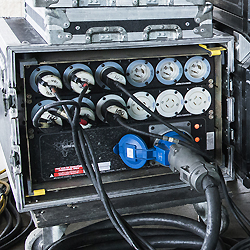
Further Clarifications
Cables have letter designations that indicate what they’re rated for. Extra-Hard usage cable is called S (for Standard use) and is rated at 600 volts AC.
Hard usage cable is designated at SJ (for Junior) and is rated at 300 volts AC. A single O means the cable has an oil resistant jacket and a double O (OO) means the cable has oil resistant insulation surrounding each conductor as well as an oil resistant outer jacket. The letter W indicates that the cable is approved for outdoor use and wet locations.
My company’s inventory includes both SOOW and SJOW cables. The SOOW cords are used on the ground where they may get walked on or rolled over by a hand truck or road case, while the SJOW cords find placement where they’re safe from physical damage, like powering up loudspeakers or run along a wall in a ballroom at a corporate event.
The NEC also allows cords to be covered by insulated matting (like a rubber runner) or enclosed in cable ramps that offer a lot of protection for the cables. Cable ramps are also great for protecting snakes and feeder cables that are located in areas where they could get damaged by carts, cases, or pedestrian and vehicle traffic.
Feeder cables are single conductor runs that consist of a Ground wire, at least one Neutral wire, and one, or more commonly two or three, Hot wires. Feeder cables tie into a generator or Company Panel Disconnect and provide power to a Portable Power Distribution System (a.k.a., PD). These systems are commonly single phase (two Hot wires) or three phase (three Hot wires).
The NEC says that single conductor supply cables cannot be smaller than 2 AWG and any ground conductor cannot be smaller than 6 AWG. Parallel conductors can be used (like a double Neutral cable), but each cable must be the same AWG rating and length. The Code also states that single conductor cables should be grouped together but not be banded. Welding cable is not approved as Feeder cable and only Entertainment-type cable (better jacket and insulation than welding type) should be used as feeder.
The connector for Feeder cables is called a Cam Lock. They can handle 400 amps at 600 volts. A smaller version called a Mini Cam can handle 150 amps and accommodate 8 to 2 AWG wire. The connectors are available in male version and female versions, and twist together with a small cam keeping the mated connectors together.
Being Prepared And Safe
Each connector in a Feeder group is color coded so users can tell what job each cable is doing. Green is used for Ground, White for Neutral lines and Black, Red and Blue for Hot. As with all power cables, typically the male ends go to the power source, but many entertainment production companies reverse the Neutral and Ground connections so colorblind stagehands do not mate the wrong conductors.
My company does not reverse Neutrals or Grounds, but we keep some Cam Lock turnarounds with our PD systems just in case we run into a disconnect that’s wired with the reverse scheme. We also travel to gigs with “Tapping Ts” that allow a second feeder cable to attach to a disconnect panel. These allow us to tie a second PD into the same disconnect (as long as we’re not overloading the box), or parallel a double Neutral cable when drawing a lot of power on a larger rig.
The other way of connecting Feeder cables is to tie in a bare ended cable Tail (a short piece of feeder with a Cam Lock on one end and bare copper on the other). Many generators and older company switched do not have Cam receptacles onboard, so the user has to tie bare ended wire into lugs.
Concerning Feeder cable, the NEC states: “Only Qualified Personnel may route, connect, energize or de-energize supply services.” The U.S. Occupational Safety & Health Administration (OSHA), defines a Qualified Person as “one who by possession of a recognized degree, certificate, or professional standing, or who by extensive knowledge, training and experience, has successfully demonstrated their ability to solve or resolve problems relating to the subject matter, the work, or the project.” In other words, don’t work with service power until you’re trained and know what you’re doing.
Electrical accidents are estimated to rank sixth among all causes of work-related deaths in the U.S. and are disproportionately fatal compared to other work-related accident types. To reduce accidents, use a non-contact voltage tester to make sure the panel being connecting to is not live. Always connect the Ground cable first, then the Neutral cables, then the Black for Load 1, the Red for Load 2 and the Blue for Load 3. To disconnect, de-energize the service and remove the cables in the reverse order of Blue, Red, Black, White and then the Green ground cable.
A PD rig is basically a portable version of the breaker box in homes. It takes service power on two or three hot wires (single or three phase) and breaks that power out into branch circuits while also providing over-current protection via breakers. Larger systems may also provide metering capabilities.
